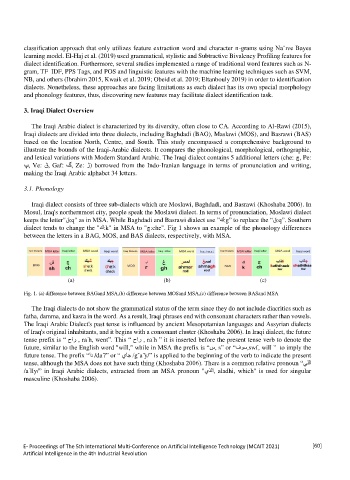Page 73 - The-5th-MCAIT2021-eProceeding
P. 73
classification approach that only utilizes feature extraction word and character n-grams using Na¨ıve Bayes
learning model. El-Haj et al. (2019) used grammatical, stylistic and Subtractive Bivalency Profiling features for
dialect identification. Furthermore, several studies implemented a range of traditional word features such as N-
gram, TF–IDF, PPS Tags, and POS and linguistic features with the machine learning techniques such as SVM,
NB, and others (Ibrahim 2015, Kwaik et al. 2019; Obeid et al. 2019; Eltanbouly 2019) in order to identification
dialects. Nonetheless, these approaches are facing limitations as each dialect has its own special morphology
and phonology features, thus, discovering new features may facilitate dialect identification task.
3. Iraqi Dialect Overview
The Iraqi Arabic dialect is characterized by its diversity, often close to CA. According to Al-Rawi (2015),
Iraqi dialects are divided into three dialects, including Baghdadi (BAG), Maslawi (MOS), and Basrawi (BAS)
based on the location North, Centre, and South. This study encompassed a comprehensive background to
illustrate the bounds of the Iraqi-Arabic dialects. It compares the phonological, morphological, orthographic,
and lexical variations with Modern Standard Arabic. The Iraqi dialect contains 5 additional letters (che: چ, Pe:
پ, Ve: ڨ, Gaf: گ, Ze: ژ) borrowed from the Indo-Iranian language in terms of pronunciation and writing,
making the Iraqi Arabic alphabet 34 letters.
3.1. Phonology
Iraqi dialect consists of three sub-dialects which are Moslawi, Baghdadi, and Basrawi (Khoshaba 2006). In
Mosul, Iraq's northernmost city, people speak the Moslawi dialect. In terms of pronunciation, Moslawi dialect
keeps the letter"ق:q" as in MSA. While Baghdadi and Basrawi dialect use ”ك:g” to replace the “ق:q”. Southern
dialect tends to change the "ك:k" in MSA to "چ:che". Fig 1 shows an example of the phonology differences
between the letters in a BAG, MOS, and BAS dialects, respectively, with MSA.
(a) (b) (c)
Fig. 1. (a) difference between BAGand MSA,(b) difference between MOSand MSA,(c) difference between BASand MSA
The Iraqi dialects do not show the grammatical status of the term since they do not include diacritics such as
fatha, damma, and kasra in the word. As a result, Iraqi phrases end with consonant characters rather than vowels.
The Iraqi Arabic Dialect's past tense is influenced by ancient Mesopotamian languages and Assyrian dialects
of Iraq's original inhabitants, and it begins with a consonant cluster (Khoshaba 2006). In Iraqi dialect, the future
tense prefix is “ حار , ra ̄h, went”. This “ حار , ra ̄h ” it is inserted before the present tense verb to denote the
future, similar to the English word "will," while in MSA the prefix is “س, s” or “فوس,swf, will " to imply the
future tense. The prefix “اد /da ̄/” or “ ياج /gˇa ̄y/” is applied to the beginning of the verb to indicate the present
tense, although the MSA does not have such thing (Khoshaba 2006). There is a common relative pronoun “يللا
/a ̄lly/” in Iraqi Arabic dialects, extracted from an MSA pronoun "يذلا, aladhi, which" is used for singular
masculine (Khoshaba 2006).
E- Proceedings of The 5th International Multi-Conference on Artificial Intelligence Technology (MCAIT 2021) [60]
Artificial Intelligence in the 4th Industrial Revolution

